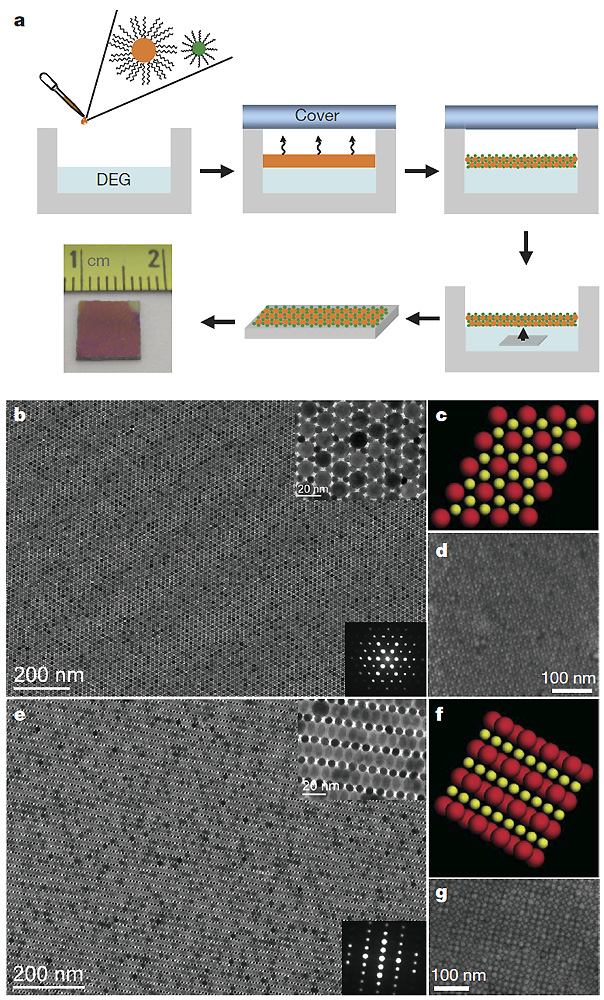Angang Dong1, Jun Chen2, Patrick M. Vora3, James M. Kikkawa3 & Christopher B. Murray1,2
1Department of Chemistry, 2Department of Materials Science and Engineering, 3Department of Physics & Astronomy
University of Pennsylvania, Philadelphia, Pennsylvania 19104, USA.

a, Schematic of the BNSL membrane growth and transfer processes. The photograph shows a typical BNSL membrane transferred to a SiO2–Si wafer. Mechanical damage from tweezers in the membrane’s upper right corner (photo) helps visualize the scale. b–g, AlB2-type BNSL membranes self-assembled from 15-nm Fe3O4 and 6-nm FePt nanocrystals. b, TEM image of the (001) lattice projection (upper inset, magnified view; lower inset, small-angle electron diffraction pattern). c, d, Crystallographic model (c) and high-resolution scanning electron microscopy (HRSEM; d) image of the (001) projection. e, TEM image of the (100) lattice projection (upper inset, magnified view; lower inset, small-angle electron diffraction pattern). f, g, Crystallographic model (f) and HRSEM image of the (100) projection (g).
The group of Chris Murray (Seed-1) has pioneered the development of a new class of self-assembled multicomponent materials made from nanocrystals. Superlattice structures are formed in which nanocrystals arrange into three dimensional superlattices with complex unit cells and long-range order. An attractive feature of this method is its flexibility in accommodating a wide range of functional nanocrystalline elements, ranging from semiconductors to metals, oxides to intermetallics, ferroelectrics to ferromagnets, etc. Until now, a limitation has been that the resulting product is not easily integrated into device architectures that often require thin film elements. In this work, the Murray group has developed a general method to grow centimeter-scale binary nanocrystal superlattice (BNSL) thin films, ranging down to single-unit cell thicknesses, which can be readily transferred to arbitrary substrates. BNSLs are formed at a liquid-air interface and are strong enough to survive transfer to a substrate without critical point drying, and to produce freely-suspended BNSL membranes. As a first demonstration, magnetic nanoparticles were used, resulting in a two-component magnetoresistive film. The Murray group has collaborated with the Kikkawa group (IRG-5) to study the magnetoresistance of these large-area (1.5mm x 32.5mm) magnetic BNSL membranes, which clearly show that device magnetoresistance is dependent on the structure (stoichiometry) of the BNSLs. This work surpasses a major obstacle in the utilization of nanocrystalline assemblies, and creates new opportunities for not only for magnetoresistive and other functional BNSLs.
A. Dong, J. Chen, P.M. Vora, J.M. Kikkawa, and C.B. Murray, “Binary nanocrystal superlattice membranes self-assembled at the liquid-air interface,” Nature 466, 474-477 (2010).
Supported through the Army Research Office, W911NF-08-1-0364 MURI and the NSF MRSEC, DMR05-20020.
